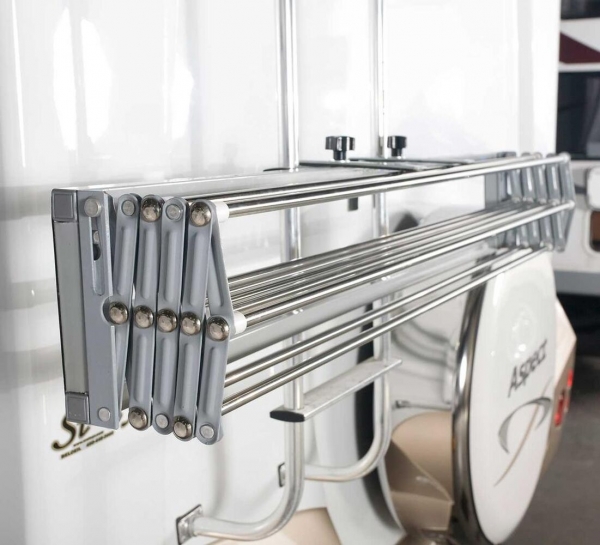Welcome to Crossing Creeks RV Resort & Spa in the heart of iconic Blairsville
Laundry day in the RV can be especially trying: Lug all your clothes and hoarded quarters to a coin-op laundry. Wait for an available washer. Load the machine. Wait. Hope another customer doesn’t scoop up the lone unclaimed dryer before your rinse and spin cycles end. Transfer clothes to the dryer. Wait. Fold. Carry everything to your car or tow vehicle. Drive back to your RV.
Wouldn’t it be nice to wash and dry right in your RV, without using the sink?
You can install a washer and dryer in your RV if you have the room, and with a portable you can at least wash an emergency load or two inside or outside your rig even if you don’t have the space for a laundry.
Finding Space
If your trailer or motorhome offered a washer/dryer option, then your RV—even if it lacks the appliances—has a place to build them in. Some cabinet modifications are probably needed. Look online for detailed plans for your RV or call the manufacturer’s customer service line to find out if your RV model can easily accommodate a washer and dryer.
If your RV was not designed for a washer and dryer, you still might be able to install the appliances in a closet or pantry. Some units, including washer-dryer combos, may fit under countertops if you remove a base cabinet.
Hookups
You’ll have to make sure hookups can be accomplished. The location of your washer and dryer should be:
- Near electrical power.
You’ll need two 110-volt outlets for two separate appliances, or one for a washer/dryer combination, 240 volts for some models. You may have to relocate electrical outlets to make sure the plug will fit between the appliances and outlet.
- Convenient to the grey tank.
You’ll have to tap into the grey tank with the washing machine’s outlet hose.
- Tall, wide and deep enough.
The space must accommodate the height of the appliances, the recommended minimum side clearance and the recommended front and back clearance. Some units require zero side clearance.
- Big enough for a vent.
Dryers come vented and unvented, but unvented dryers dump excess moisture into your RV interior. Venting through an exterior wall is preferable.
Appliance Styles
Options abound, making it possible to add a washer/dryer to just about any RV bigger than a teardrop or popup. And thanks to small portables, you can even do laundry in or outside one of those smaller campers.
Here’s what’s available to build in:
Washer/dryer combo. About the size of a washer alone, these front-loading units turn into a dryer after the wash, rinse and spin cycles. That saves space. Some, such as the Splendide 2100XC, automatically start drying when the washing is done. The capacity of the washer is 15 pounds, and the dryer, 11 pounds. Cost: $1,100 to $1,350.
Stackable. An RV-size front-load washer and dryer stacked, such as the Equator EW 824 and ED 850, require only the footprint of the washer, about 23 inches wide and 22 inches deep, but need about 5 feet in height. The washer is on the bottom and the dryer on top. The washer and dryer each hold 13 pounds. Cost: $1,250-$1,500.
Stacked integrated unit. Often found in apartments, these compact units have a washer on the bottom and a dryer on top. They are made as one tall unit, each about 28 inches wide. The GE Spacemaker Laundry Center needs about 6½ feet of height. It can handle 3.8 cubic feet for washing and 5.9 for drying. Some models may require a 240-volt line and breaker. Cost: $1,250-$1,500.
Portables for Tight Spaces
Tiny alternatives—portable units that wash a small load and spin the items quite dry in a separate drum—help out in small campers. An example is the Best Choice Model SKY5406 twin-tub washer. It can wash a small load, about 8 pounds, with a separate spinning drum that can dry up to 5 pounds. With a power demand of 140 watts or less, it’s possible to run on solar power. Cost: $95-150.
Portables have hoses or hookups for hoses, or you can just fill from a bucket or large bottle. These units aren’t always automatic. You may have to add water for the rinse, and the dryer drum uses the low-tech method of sensing if clothes are dry: Stop and feel them. Drain into your shower or use natural, biodegradable soap and drain outside where permitted.
Clothes Lines
If you go without a dryer, or if you use a portable, you’ll need to hang your laundry to dry.
Look for something that has convenient setup and teardown. The Smart Drier clamps onto the ladder of your camper and opens to reveal several lines for hanging clothes and linens. With the sun reflecting off your RV, clothes dry quickly, especially if hung after being spun thoroughly. Cost: $100 or less.
The Australian-made Versaline Traveller Compact RV Clothesline hangs on two wall brackets that you screwed into a side or back exterior wall of an RV or to vehicle. It removes easily and folds into a carrying case when you’re done. Cost: $150 or less.
Image Credits: campingworld.com
Leave a comment
Make sure you enter all the required information, indicated by an asterisk (*). HTML code is not allowed.
